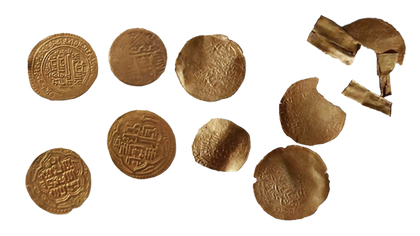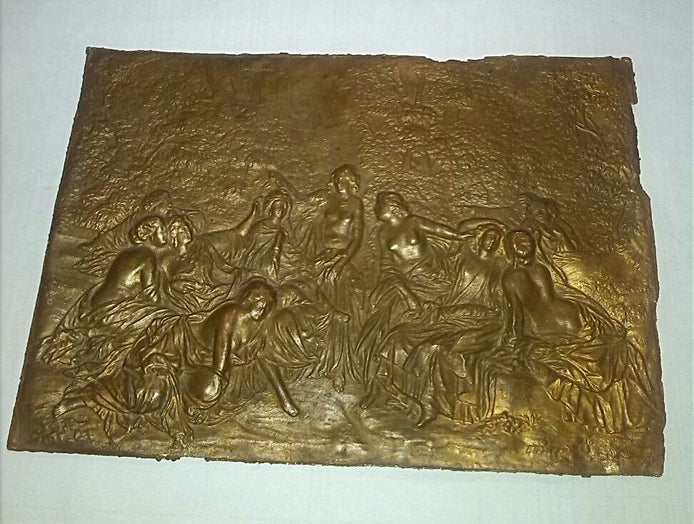Gold Coins Detected with Bionic X4

Detected with
OKM Bionic X4
Region: Iran
Legendary Gold Coin Discovery with the OKM Bionic X4
Some stories sound like they were written for history books – and this one starts with a single signal. In the vast landscapes of Iran, a treasure hunter followed the silent guidance of his detector and uncovered something extraordinary: centuries-old gold coins from the era of Ilkhan ruler Mahmud Ghazan. The key to this discovery? The OKM Bionic X4.
What began as a regular treasure hunt quickly turned into a remarkable success story that connects modern detection technology with the rich legacy of medieval Persia and the cradle of civilization: Mesopotamia.

From Signal to Sensation – A Treasure Hunter’s Success Story
A Golden Moment in Iran
In a region steeped in history, a treasure hunter equipped with the OKM Bionic X4 detected several promising signals. Layer by layer, the soil was removed – until the glint of gold broke through the earth. The find: multiple golden coins, so-called dinars, likely struck under the rule of Mahmud Ghazan in the late 13th century.
These coins are not just precious metal. They are material witnesses of a powerful dynasty, of trade, war, religion, and cultural exchange. Holding such a coin in your hand means holding more than 700 years of human history.
Why the Bionic X4 Was the Game Changer
The Bionic X4 is designed for long-range detection of gold and other precious metals. In this case, it enabled the treasure hunter to systematically narrow down the search area and target promising zones instead of scanning blindly. This transformed a random search into a focused and data-supported detection strategy – and ultimately led to the discovery of the gold dinars.
The Gold Dinars of Mahmud Ghazan
What Exactly Are Dinars?
The term dinar refers to a historic gold currency used across southeastern Europe and the Islamic world. For centuries, dinars were a benchmark for value, trade, and political power. The coins discovered with the Bionic X4 are most likely gold dinars from the era of Mahmud Ghazan – a ruler whose decisions shaped an entire region.
Historical Context: Value Beyond Today’s Currency
While modern currencies like the Kuwaiti dinar or Jordanian dinar still bear the name, the discovered coins are not part of any current monetary system. Instead, their value lies in their rarity, historical significance, and numismatic importance. They are unique artifacts from a time when empires rose and fell along the trade routes of the Middle East.
Estimated Value and Collectors’ Interest
Due to their age, condition, and historical relevance, such dinars can reach a value of up to 3,000 € per piece. Beyond pure financial worth, collectors and museums value them as tangible references to a dynamic and transformative chapter of Persian and Mongol history.

Ilkhan Mahmud Ghazan: An Influential Ruler
From Buddhist Prince to Muslim Ruler
Mahmud Ghazan, often referred to as Ghazan Khan, was one of the most impactful rulers of the Ilkhanate – a Mongol dynasty that controlled vast territories from Persia across Mesopotamia to Central Asia between 1256 and 1335.
Born and raised in the Buddhist tradition, Ghazan converted to Islam in 1292 at the age of 21. When he came to power in 1295 as the seventh Ilkhan ruler, he initiated sweeping religious and political reforms and anchored Islam as the state religion.
Political Reforms and Cultural Transformation
Ghazan did not only shift religious policy. He also strengthened Persian culture, promoted administration in Persian and Arabic, and supported scholars and artists. Under his leadership, the Ilkhanate reached one of its greatest territorial expansions – stretching from regions of present-day Pakistan to areas of modern Turkey.
Despite his achievements, Ghazan faced constant internal challenges: revolts, corruption, and disloyalty undermined the stability of his reign. Attacks on peasants and workers, combined with limited ability to enforce lasting order, strained the internal political climate.
After his death in 1304, his brother Öldscheitü took power. The era of relative religious tolerance that had characterized Mongol rule eroded. Administrative neglect and fragmentation eventually paved the way for new regional dynasties to rise across former Ilkhanate territories.
Mesopotamia – Cradle of Civilization and Strategic Crossroads

Source: Свифт/Svift, Public domain, via Wikimedia Commons
Mesopotamia – the land “between the rivers” Tigris and Euphrates – is often referred to as the cradle of civilization. From about 3500 BC to 539 BC, it was home to some of the earliest advanced cultures in human history: Sumerians, Babylonians, and Assyrians.
Together with Ancient Egypt, Mesopotamia formed a powerful axis of trade and cultural exchange. Goods, ideas, and beliefs crossed deserts and rivers: grain, wood, metals, gemstones, pottery, jewelry, textiles – and with them, knowledge and innovation.
Writing systems were among the most influential exports. Mesopotamia developed cuneiform script, while Egypt shaped hieroglyphs. Evidence suggests that both cultures were familiar with each other’s scripts – an early example of cross-cultural literacy.
The Sumerians in southern Mesopotamia were pioneers in many domains. Their cuneiform writing is considered the world’s first writing system and laid the foundation for recording laws, literature, trade, and historical events. They also advanced agriculture with irrigation systems, plows, and the use of oxen. These innovations enabled stable food production, city development, and the emergence of complex societies – a foundation that still echoes in our modern world.

Source: Juan Carlos Fonseca Mata, CC BY-SA 4.0, via Wikimedia Commons

Source: KJZ, CC BY-SA 2.0, via Wikimedia Commons
The Babylonians, who took control of Mesopotamia in the 18th century BC, were renowned for their legal system, mathematics, and astronomy. The famous Code of Hammurabi, with its “eye for an eye” principle, shaped the development of legal frameworks across many subsequent cultures.
Babylonian astronomers observed celestial bodies, developed one of the earliest calendars, and introduced pioneering mathematical concepts such as a base-60 number system. Even today, our 60 minutes per hour and 360 degrees in a circle can be traced back to their innovations.
The Assyrians, rulers of northern Mesopotamia, built a powerful military state known for its strategic warfare and expansive empire, stretching from Egypt to Persia. Their monumental palaces and reliefs still impress visitors and scholars alike, capturing scenes of warfare, hunting, and royal power.

Source: Кучумов Андрей, Public domain, via Wikimedia Commons
In addition to cultural and political advances, Mesopotamia was a major trade center. Standardized weights and measures, legal codes, and contracts created a framework for economic activity that foreshadowed modern business practices. Towering ziggurats, intricate sculptures, ceramics, and jewelry testify to a refined artistic tradition that still inspires artists and designers today.
Why Ancient Civilizations Still Matter for Modern Treasure Hunters
For treasure hunters and detectorists, the legacy of Mesopotamia and the Ilkhanate is more than a distant history lesson. It provides crucial context: trade routes, settlement patterns, religious centers, and military campaigns often left behind material traces such as coins, jewelry, and ceremonial objects.
Those who invest in historical research gain a clear edge in the field. Instead of relying solely on chance, they follow data: maps, chronicles, archaeological reports – and then correlate this information with modern detection technology like the Bionic X4.
The OKM Bionic X4 in Focus
Long-Range Detection for Gold and Precious Metals
The OKM Bionic X4 is engineered specifically for long-range detection of gold and other precious metals. It supports treasure hunters in:
- Locating potential gold deposits at long distances
- Focusing search efforts on the most promising areas
- Reducing time and effort compared to random scanning
In the Iranian coin discovery, the Bionic X4 helped transform a historically promising landscape into a concrete, targeted find.
Ideal Use Cases: From Coins to Buried Hoards
The Bionic X4 is ideal for:
- Historic coin finds (like gold dinars)
- Buried hoards and caches
- Hidden jewelry and artifacts in remote or expansive terrain
Whether you are working near historic caravan routes, ancient cities, or former trade hubs, the Bionic X4 offers a strategic advantage by combining direction finding with long-distance detection.
Why Professional Treasure Hunters Trust OKM
OKM detectors are used worldwide by professional treasure hunters, archaeologists, and exploration teams. The combination of advanced technology, robust hardware, and specialized expertise enables high-performance underground detection across a wide range of applications – from hobby treasure hunting to serious research projects.
Best Practices for Responsible Treasure Hunting
Legal Requirements and Permissions
As inspiring as stories like this coin discovery are, responsible treasure hunting always starts with compliance. Depending on your country and region, you may need:
- Landowner permission
- Official licenses or permits
- Coordination with heritage or archaeological authorities
Before starting any search, it is essential to clarify the legal framework and act in full alignment with local regulations.
Preservation of Cultural Heritage
Historical finds like Mahmud Ghazan’s dinars are cultural assets. In many cases, authorities or museums should be informed so that the objects can be documented, preserved, and – ideally – made accessible for public education. Treasure hunting then becomes more than a personal hobby: it contributes to preserving and enriching our shared history.
Conclusion: When Technology Meets 700-Year-Old History
The discovery of Mahmud Ghazan’s gold dinars is a powerful example of what happens when historical knowledge, modern technology, and persistence intersect. A detectorist in Iran, guided by the OKM Bionic X4, not only found gold – he uncovered a direct connection to a ruler, an empire, and a region that helped shape the world as we know it.
From Mesopotamia’s early cities to the Ilkhanate’s golden coins, the past is still out there, buried in the ground and waiting to be rediscovered. With the right tools, the right preparation, and the right respect for history, every signal in the headphones could be the beginning of the next great story.
FAQ – Gold Finds, Dinars, and the OKM Bionic X4
How was the gold coin hoard discovered with the Bionic X4?
A treasure hunter in Iran used the OKM Bionic X4 to systematically scan a historically promising area. The device provided directional information and long-range detection, allowing the hunter to narrow down the search zone. Step by step, this led to a concentrated excavation spot – and ultimately to the discovery of multiple gold dinars from the era of Mahmud Ghazan.
Are Mahmud Ghazan dinars rare and valuable?
Yes. Gold dinars from Mahmud Ghazan’s reign are historically significant and highly sought after by collectors and institutions. Depending on condition and rarity, their value can reach up to 3,000 € per coin. However, their true value goes beyond money: they are irreplaceable evidence of a key period in Middle Eastern and Mongol history.
Can beginners use the Bionic X4 successfully?
The Bionic X4 is a professional device and offers best results when users are trained and prepared. Beginners can absolutely benefit from it, especially if they:
- Take time to learn the device functions and modes
- Combine its use with basic historical research
- Practice in different terrains to understand signals
Many users choose to work closely with OKM training or experienced detectorists to unlock the full potential of the Bionic X4.
Do I need official permission to search for historical coins?
In most regions, yes. Legal frameworks differ by country, but generally you will need the landowner’s permission and, in some cases, approvals from heritage or archaeological authorities. This applies particularly to historically sensitive areas and potential cultural monuments. Always clarify applicable laws before you start searching.
Why combine historical research with modern detectors?
Historical research turns a random search into a strategic project. Maps, chronicles, archaeological reports, and trade route reconstructions help identify high-potential areas. Advanced detectors like the Bionic X4 then translate this knowledge into actionable on-site results. The combination of both dramatically increases efficiency, success rates, and the historical value of the finds.
Get Rewarded for Your Treasure Finds
You have also made discoveries and detected amazing artifacts and would like to share them (anonymously)? We look forward to reading and publishing your success stories!


